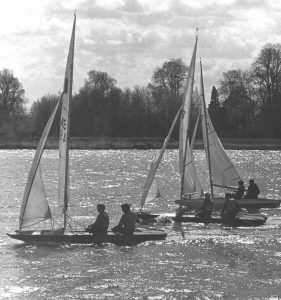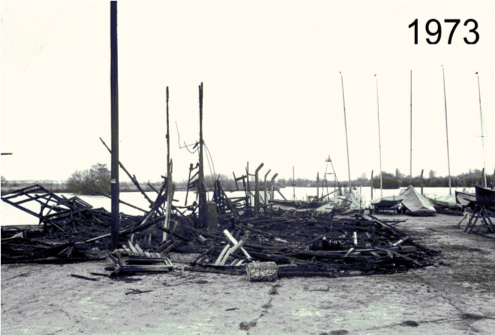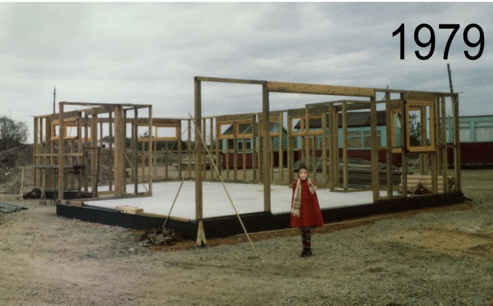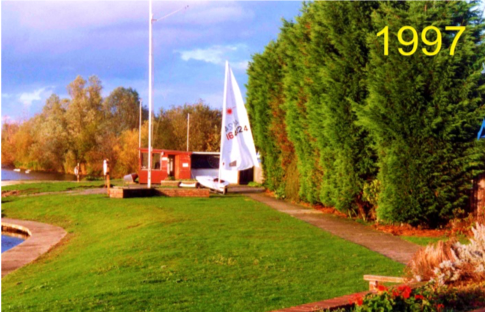The Club was founded in May 1957 by a group of keen would-be sailors from British European Airways. Beverly Shenstone, BEA chief engineer at the time was a resident of Wraysbury and a friend of gravel pit owner Thomas Roberts and, though gravel extraction was ongoing, it was agreed that BEA sailors could use the lake subject to working requirements. Roberts would make a spare cabin in their works available as a changing area and put in a slipway. The airline agreed to finance the purchase of six boats and to build a compound if 60 members could be signed up. Sixty signatures duly obtained, a new dinghy, the Enterprise, designed by Jack Holt and sponsored by the News Chronicle was chosen as the boat and Silver Wing Sailing Club was born. The first boats were Enterprises 681, 683, 685, 687, 689 and 691. The next ten years saw uninterrupted growth in membership, facilities, boat ownership and ambition in the sailing programme.

With continuing gravel extraction the total water area increased to nearly 120 acres and though not all of it was usable some members were encouraged to take up a new and faster dinghy, the Fireball. The number of boats at the Club rose to around 80 and Enterprise sailing was boosted by an influx of new members from Gillette Sailing Club who had lost their water at Bedfont.
Open meetings and team events soon acquired a reputation for efficient organisation and included a nationally recognised Fireball team championship.
The Club were hosts to the 1967 Enterprise Junior National Championship and made international contacts with airline sailors from KLM (1961) and Austrian Airlines (1963). Global connections were truly established at the first World Airline Sailing Championship (WASC) hosted by Qantas in Sydney in 1974 to rules drafted by Silver Wing Sailing Club.

There were, however, clouds on the horizon. In the 1960’s gravel companies were required to restore land after extraction and back filling with spoil from the new Wraysbury Reservoir site commenced at the north east corner of the lake in 1966. Within two years the clubhouse and boat park were left overlooking a small basin connected via a narrow channel to the main area of water to the west.
Then, in the winter of 1973/4 fire destroyed the changing rooms and a number of boats berthed alongside.
Organisation and hosting of the first European airline version of the WASC (ASCA) provided a brief highlight in the summer of 1976 but later that year a conveyor system to bring raw material into the processing plant was built across the channel and cut off the clubhouse from the sailing and boats had to be dragged through the ready-mix concrete plant to temporary slipways. Though a small hut was erected to give sheltered viewing over the water conditions were clearly unviable in the long term and the Club started a serious search for an alternative location.

The alternatives, to move or to rebuild the Club from the ground up, were put to a special general meeting in July 1977. Members were almost unanimous in voting to stay at Wraysbury and set about building up the Club as we now know it.
Though some money was available from the airline, planning delays and inflation required severe pruning of the original clubhouse concept and even then available funds barely covered the cost of the shell. There was nothing for heating, showers or any internal fittings.

Nevertheless, by August 1980 the Clubhouse, decorated with potted plants and a red ribbon across the door was ‘ready’ to be opened by the then chairman of British Airways Clubs, Dr. Graham Taylor. Limited budget notwithstanding, the Club was determined that the site was not going to be the makeshift affair characteristic of many others. Paths would be straight and level, slipways would extend underwater, dinghy berths and tie-downs would be built in.
Though carried out by amateurs, professional standards of design and construction were applied to the furnishing of the clubhouse. Many talents and much ingenuity were deployed in developing schemes that could be implemented by volunteer labour but the effort did take it’s toll and after some two years of steady toil there was a clear need to refocus on the sailing.

In the late 80s the small clubhouse building was getting largely cramped for a growing membership. Our membership desperately needed a bigger building with more space. So an extension was planned. It would see a spacious lounge with big windows, a high ceiling and a bar! The project was completed in 1991 and is the Pinelog extension to the Clubhouse, purchased out of member’s funds, to provide a carpeted lounge and bar and opened in 1991. This made good many of the sacrifices associated with the original building and now provides a sybaritic setting for social gatherings and also allows different activities to take place simultaneously. Again much of the internal work was carried out by members.
The increasing importance of the environment was recognised in 1992 when Silver Wing Lake, together with the surrounding lakes and meadows, was declared a Site of Special Scientific Interest for the range of birdlife and other species it now supports.

Our old location became a landfill site which was closed in the late 90s. The FCC landfill site is now the site of a 5.3 Ha Solar Farm. There are 11,000 solar panels that generate 3.1MW of clean electricity to the national grid, this is the equivalent of powering 963 homes per year!

In 2012 to coincide with the London Olympics we became an RYA training centre. This would see us provide high quality coaching and instruction, as recognised by a national governing body, to over 80 kids and adults each year.
Over the years we have also built up our own pool of 25 instructors, which is now self sustaining through our very successful Sunday afternoon “Wing Cadets” program, in which we provide sailing tuition to 8-16 year olds to build them up from beginner to racer or instructor standard.

